#hoplitodromos
Text
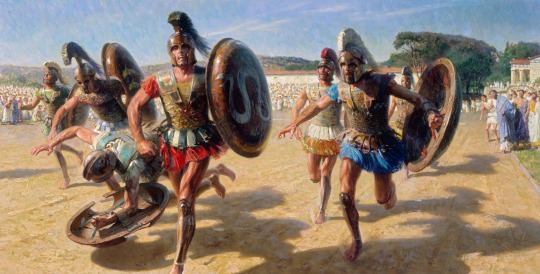
The Hoplitodromos "Race of the Hoplites" Ancient Olympics
by Tom Lovell
The first Olympic games were a one-day, one-competition event. The event was a footrace, and the event was held in Olympia, Greece, in 776 BC. The games were held roughly every four years until AD 393. One of the ancient events was the "hoplitodromos," a footrace where athletes competed in heavy armour, shield, and helmet.
#ancient#olympics#olympic games#art#illustration#tom lovell#athletes#hoplites#race#armour#shield#helmet#runners#ancient greek#ancient greece#greek#greece#sport#panhellenic#olympia#hoplitodromos#hoplite#running#sprint#aspis#history#europe#european#panhellenic games
92 notes
·
View notes
Text

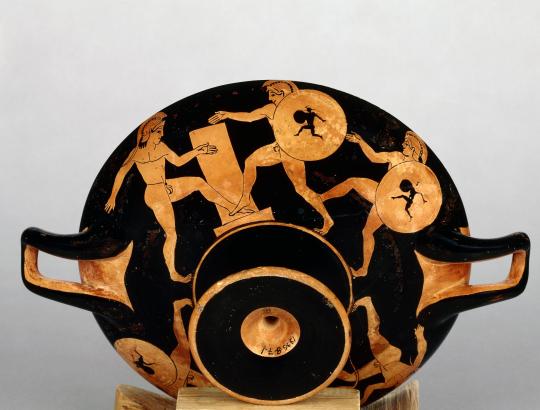
Red-figure kylix: showing a six youths (hoplitodromoi) racing with helmets and shields; meander pattern and inscriptions in tondo.
Potter: attributed to Euphronios; Painter: attributed to the Colmar Painter. Attic, 490-480 BC.
Diameter: 23.20 centimetres; Height: 9 centimetres Width: 30 centimetres (across handles) (across handles)
I like it that the youths are carrying shields showing youths practicing their sport!
#British Museum#Euphronios#Colmar Painter#Greek ceramics#Red-figure#hoplitodromos#agon#Greek athletes#kylix#symposium#greek athletics#hoplites
2 notes
·
View notes
Text
How Naked Men Wrestling Saved The Western World
In ancient Greece the Olympians of the day fought in the buff. It literally saved the Greek world from becoming a Zoroastrian state.
Greek city states were tiny countries around the coast of the Aegean Sea, and further afield around the Mediterranean. They competed each other for supremacy in commerce. This was in the centuries before BC became AD. Underlying their commercial competitiveness,…
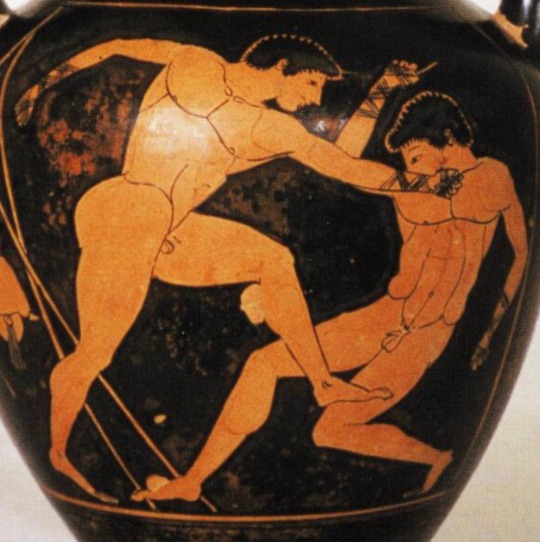
View On WordPress
#ancient games#Aristotle#Athens#Attica#discus#festival#hoplites#hoplitodromos#marathon#motivation#Olympia#Olympic#Olympic festival#shield#Socrates#teaching#Thermopylae#Xeus
1 note
·
View note
Text



Leonidas || Fineliner and acrylic marker / text under the readmore / click for better res
Leonidas of Rhodes (Ancient Greek: Λεωνίδας ὁ Ῥόδιος; born 188 BC) was one of the most famous ancient Olympic runners. For four consecutive Olympiads (164–152 BC), he was champion of three foot races.
Leonidas is acclaimed by some to be the greatest sprinter of all time. Competing in the Olympic Games of the 154th Olympiad in 164 BC, the last of the "golden age" of the ancient Games, Leonidas captured the crown in three separate foot races: the stadion, the diaulos, and the hoplitodromos. He repeated this feat in the next three subsequent Olympics, in 160 BC, in 156 BC, and finally in 152 BC. Leonidas's lifetime record of twelve individual Olympic victory wreaths was unmatched in the ancient world.
There is very little biographical information about Leonidas, and no images of him survive. But his name - derived from the Greek word for lion - suggests he was a man of distinction. After his death, Leonidas was worshipped as a local deity in Rhodes. There, a statue of him displays the legend: "He had the speed of a God."
#sebastian vettel#f1#f1 art#yeah guess what. i am still not over seb saying he'll be forgotten when we still know the names of athletes from thousands of years ago#shut up fuckface you are way too beloved#fucking. dinosaur skeletons. they have NAMES and we have to tell people not to climb them. because we LOVE THEM SO MUCH#CAVE PAINTINGS OK#AND HE THINKS HE'LL BE FORGOTTEN#RESPECTFULLY SHUT UP ASSHOLE I WILL NOT#MY LAST THOUGHT BEFORE MY DEMENTIA RIDDEN BRAIN GIVES OUT WILL BE OF YOU AND THERES NOTHING YOU CAN DO ABOUT IT BITCH#i felt very smart doing bull and horse wall paintings behind him ngl
180 notes
·
View notes
Text
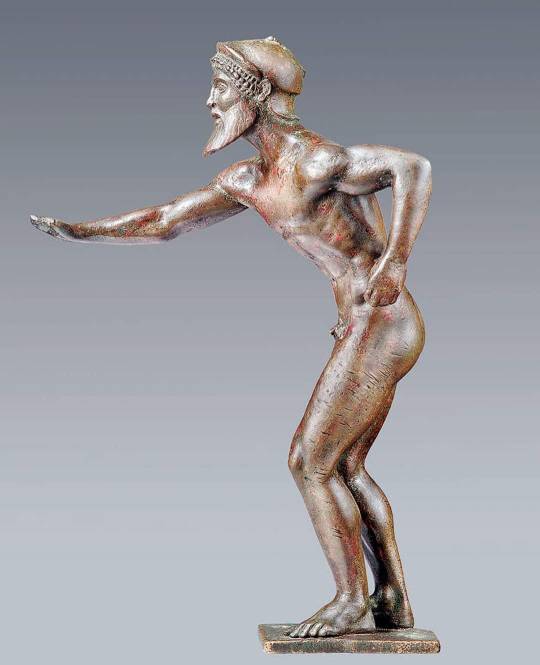
Statuetta in bronzo di un hoplitodromos (corridore oplita armato) - 500 a.C. circa - alt. 0,164 m - Museo dell'Università di Tubinga, D - inv. n. 1
11 notes
·
View notes
Text
Edie Olympian info;

Her full name is Edith Myrtle Olympian of the Isle.
Only her friends can call her by her nickname. It annoys her otherwise.
Her nickname is pronounced 'Ee-d-ee' not 'Eddie'.
She is Eris' daughter.
She is 20 by the time the events of the Pocketwatch/Rise of Red occur.
She, like Hadie and the others, has taken to following the Badun Detective Agency around ever since the barrier was brought down.
She is one of Hadie's minions and is very protective of her younger cousin (?).
She also gets along surprisingly well with Herkie, Elle, Arabella, and their other cousins. Even Mal.
She has been said to have a patience of a Saint.
Edith's favorite colors are various shades of purple, blue, and pink.
Edith gets along quite well with her mother despite the many differences between them.
She has inherited her mother's powers.
She is also failing nearly every dumb class Auradon has.
Edith does her best to avoid Red's mother and her hair salon at all costs because the Queen of Hearts frankly scares her. Not that she'd ever willingly tell Red that (she doesn't want to hurt her feelings).
When she needs money, she'll occasionally pick up a shift at Ursula's fish and Chips of Hades' restaurant.
She's not very religious.
She's not very fond of most of the gods and goddesses for how they treated her mother.
She's single but that doesn't really bother her because she's not interested in romance all that much.
She, like Deja, has an unsettling fascination with death and the occult. She also loves horror movies a little too much.
Edith has at least 13 older siblings. Since her mom is a goddess it is hard to know for sure.
She is apart of the Sea Ponies club, the debate club, & the Scammers and Pickpockets club.
While she has the patience of a saint, she can be very petty when that patience has been worn thin.
When someone upsets her greatly, she will switch to Greek and refuse to switch back. Which in Auradon can be very annoying since not a lot of people there are multilingual.
She has natural blood red eyes and blonde hair.
She had a much better childhood than most of the kids on the isle, despite her father leaving when she was young.
She literally does not have a dad.
Out of both her friend groups, she is the closest to Hadie and Deja.
She loves singing, dancing, acting, pulling pranks, clay sculpting, chariot racing, foot racing, pentathlon, pankration, bulding catapults, and hoplitodromos.
Her weapon of choice is halbered. She also knows how to wield the following weapons: the Kopis, Dory, Sarissa, Ballista, and spear.
She also quite enjoys 'chaotic' musical instruments, even if other folks don't.
She is unapologetically herself and doesn't care what anyone else has to say about it.
Bonus:

Shan Deja, Hadie Olympian, Edie Olympian, Glauco White, Maddox Hatter, Chloe Charming, Red Hearts, and Danny Darling.
#descendants#disney descendants#melissa de la cruz#the pocketwatch#rise of red#descendants oc#disney descendants oc#disney descendants alternate universe#descendants alternate universe
8 notes
·
View notes
Text
Closed w/ @hcwthewestwaswcn
Olympus stood bright and buzzing as Greece below them prepared for another Olympic Games. Zeus himself stood proud and excited as below, mortals planned to compete with other skilled young men in his honor, and he was looking forward to seeing the new addition of the event the hoplitodromos, a foot race where the participants were fully naked apart from a heavy helmet, greaves, and a sturdy shield, making it a test with extra endurance. Absolutely buzzing from the high of being on the mind of everyone in the various city-states, Zeus found himself calling upon several nymphs to be by his side as he prepared to watch the games.
5 notes
·
View notes
Text
Άγαλμα Σπαρτιάτη πολεμιστή
Το άγαλμα σπαρτιάτη πολεμιστή ή οπλιτοδρόμου, γνωστό και ως Λεωνίδας φιλοξενείται στο Αρχαιολογικό Μουσείο Σπάρτης – «The smiling Spartan» – Statue of a hoplitodromos (running hoplite), known as “Leonidas”. Marble. 480—470 BC. Sparta, Archaeological Museum Βρέθηκε στη Σπάρτη στις αρχαιολογικές ανασκαφές της Αγγλικής Σχολής κατά τα έτη 1924 – 25. Βρέθηκε πάνω από το ρωμαϊκό […]
Άγαλμα Σπαρτιάτη…
View On WordPress
0 notes
Text
Άγαλμα Σπαρτιάτη πολεμιστή
Το άγαλμα σπαρτιάτη πολεμιστή ή οπλιτοδρόμου, γνωστό και ως Λεωνίδας φιλοξενείται στο Αρχα��ολογικό Μουσείο Σπάρτης – «The smiling Spartan» – Statue of a hoplitodromos (running hoplite), known as “Leonidas”. Marble. 480—470 BC. Sparta, Archaeological Museum Βρέθηκε στη Σπάρτη στις αρχαιολογικές ανασκαφές της Αγγλικής Σχολής κατά τα έτη 1924 – 25. Βρέθηκε πάνω από το ρωμαϊκό […]
Άγαλμα Σπαρτιάτη…
View On WordPress
0 notes
Text
Άγαλμα Σπαρτιάτη πολεμιστή
Το άγαλμα σπαρτιάτη πολεμιστή ή οπλιτοδρόμου, γνωστό και ως Λεωνίδας φιλοξενείται στο Αρχαιολογικό Μουσείο Σπάρτης – «The smiling Spartan» – Statue of a hoplitodromos (running hoplite), known as “Leonidas”. Marble. 480—470 BC. Sparta, Archaeological Museum Βρέθηκε στη Σπάρτη στις αρχαιολογικές ανασκαφές της Αγγλικής Σχολής κατά τα έτη 1924 – 25. Βρέθηκε πάνω από το ρωμαϊκό […]
Άγαλμα Σπαρτιάτη…
View On WordPress
0 notes
Text
Άγαλμα Σπαρτιάτη πολεμιστή
Το άγαλμα σπαρτιάτη πολεμιστή ή οπλιτοδρόμου, γνωστό και ως Λεωνίδας φιλοξενείται στο Αρχαιολογικό Μουσείο Σπάρτης – «The smiling Spartan» – Statue of a hoplitodromos (running hoplite), known as “Leonidas”. Marble. 480—470 BC. Sparta, Archaeological Museum Βρέθηκε στη Σπάρτη στις αρχαιολογικές ανασκαφές της Αγγλικής Σχολής κατά τα έτη 1924 – 25. Βρέθηκε πάνω από το ρωμαϊκό […]
Άγαλμα Σπαρτιάτη…
View On WordPress
0 notes
Text
oh my GOD they need to bring back the hoplitodromos for the olympics
i wanna see people running in full armor
#i know this isn’t feasible but it would be soooo cool#esp if each country competing used traditional armor from their country#it would have to be standardized for weight but COME ONNNNN#that sounds awesome
1 note
·
View note
Photo
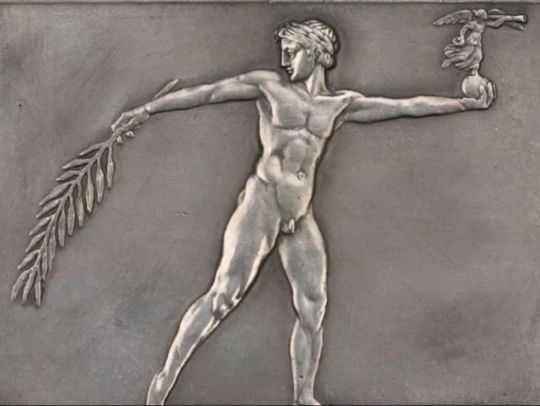
75º [480 a.C.]. Astylos de Crotona/Syracusa pela terceira vez, corrida do Stádium Astylos já havia vencido os 73º e 74º Jogos Olímpicos nas provas de corrida do Stádium e diaulos, feito que repetiu em 480 a.C. e desta vez ainda venceu a corrida Hoplitodromos, vestido com armadura completa novamente pela cidade de Syracusa. Pelo feito ele não só igualou-se ao maior atleta das corridas até então, Chionis de Esparta, mas o superou, porque esta terceira vitória concedeu-lhe o título de periodonikes que consagrou aqueles que venceram em todos os Jogos Pan-helénicos. Astylos foi um dos melhores corredores nos Jogos da Antiguidade, pois ele conquistou oito vitórias em doze anos de competição nos jogos olímpicos, entre 488 e 476 a.C. nas corridas do estádio e dos diaulos. Apesar de ter ido para Syracusa em busca de fama e honra, sua vida tornou-se muito solitária e sofrida. Após deixar a vida de atleta, isolou-se por muitos anos, sendo visto apenas por caçadores correndo pela mata como um ermitão. Nestes jogos tevemos a vitória de Xenopithes de Keos na fase juvenil da corrida do Stádium, Dromeu de Stymphalian na corrida de Dólicos, Kon de Argos na luta juvenil, Dromeu de Manteneia no pancrácio e Theagenes de Thasos no pugilato. Dizem que Theagenes derrotou Euthymos de Locres, campeão da olimpíada anterior, apenas para ferir seu rival, os juízes o multaram por considerar que havia participado do pugilato por motivos próprios, e não pelo Agon. Na sua volta para Thasos decidiu arrancar uma estátua de bronze de um deus de sua base, do mercado de Thassos, e levá-la para casa. Os cidadãos de Thassos tomaram isso como uma blasfêmia que merecia a morte do ladrão. Um velho sugeriu que o melhor seria simplesmente o menino devolver a estátua ao seu local de origem. Theagenes fez isso, então sua vida foi poupada, mas a história de sua ação se espalhou por toda a Grécia. Ainda tivemos como vencedores Teopompos de Heraia no pentatlo, a Equipe de Argos na corrida de cavalos, Daitondas e Arsilochos de Tebas nos carros e Anaxilas de Region (Region, na Calabria) nas apénes (bigas com mulas). Após os jogos inicia a II Guerra Médica (Contra Persas, entre 480 e 479 a.C.). (em Olímpia - Grécia) https://www.instagram.com/p/CgYZlQVMLDI/?igshid=NGJjMDIxMWI=
0 notes
Photo
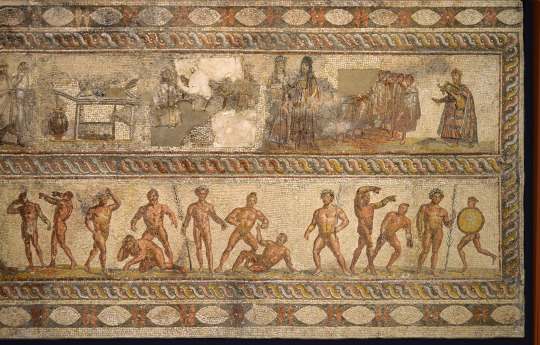


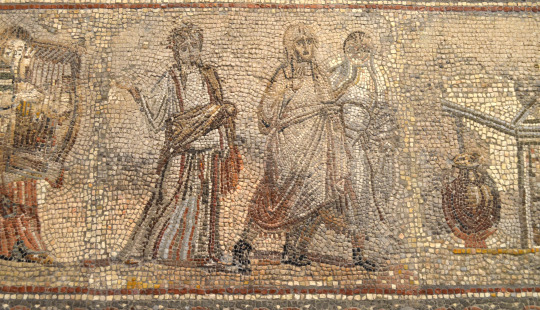

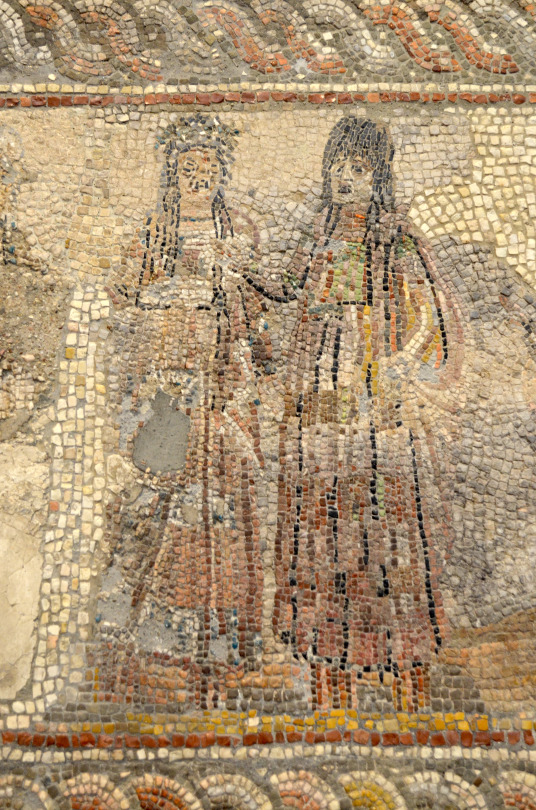

Archaeological Museum of Patra:
Mosaic floor with artistic and athletic contests
Multi-colored mosaic floor from a significant building at Psila Alonia. Two decorative zones with friezes illustrating various figures are framed by ogival pattern and astragalus.
The upper zone depicts scenes from musical and dramatic events: a musician playing an avlos (flute) supports what is probably a poetic contest between two figures; a guitar player and three comedians follow, heading towards a table with prizes at the middle of the picture. A group of tragic actors is being followed by a chorus, tragic or dithyrambic, with a guitar player standing to its right, dressed in official clothing.
The lower zone portrays athletic games, a combination of “traditional” greek events popular with Romans. From left to right: a torch relay runner, a “hockey player”, a discus thrower, a jumper, wrestlers, boxers, and a hoplitodromos (runner carrying a spear and shield). Depictions of wreathed athletes holding palm branches are inserted between the athletic scenes.
Patras. Late 2nd - early 3rd cent. A.D
These are some exhibits relevant to the cultural life of ancient Patras during the Roman period from the 1st to the 2nd century A.D. Mostly terracotta masks of satyrs and female roles - these wouldn’t be used in performances, they are more like commemorative souvenirs from popular roles one could collect in a market outside a theater.
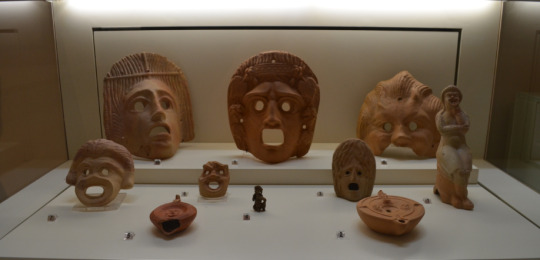
And lanterns depicting various pairs of gladiators in sensational moments from their matches.
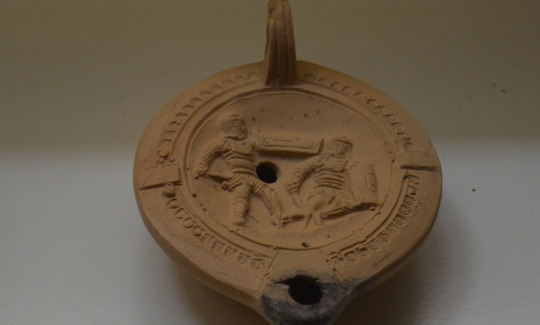

Again these little clay lanterns were made in bulk, and were extremely cheap, they were bought at souvenirs by the audience on their way in or out of the stadium. These objects paint an interesting picture about “fan life” in ancient Patras.
Speaking of sport these two gesturing guys in the mosaic are particularly interesting - and I am wondering is this something with meaning in the context of their sport? Or are these guys addressing the cheering audience like athletes today do?

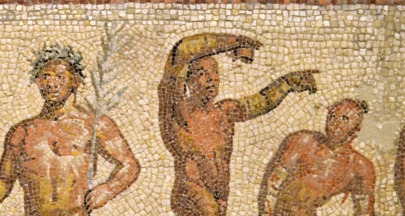
So ancient Patras a vibrant town full of fun loving people loving the arts and naked oiled dudes, or ancientpunk dystopia living vicariously through spectacle?
-----------------------
You: Like, Follow, Reblog. Me, an intellectual: Caffeinated drinks, pls? https://ko-fi.com/isabia
#ancient greece#mosaics#tagamemnon#ancient theater#ancient sports#gladiators#greece#greek roman period#archaeology#archaelogical museums#archaeological museum of patra#museums#patra#masks#ancient art#ancient mosaics#αρχαία ελλάδα#ελλάδα#πάτρα#αρχαία μωσαϊκά#μωσαϊκό#αρχαιολογικό μουσείο πάτρας
316 notes
·
View notes
Text
I think the International Olympic Committee should stop being cowards and bring back the venerable Ancient Greek Olympic sport of the hoplitodromos.
19 notes
·
View notes
Photo
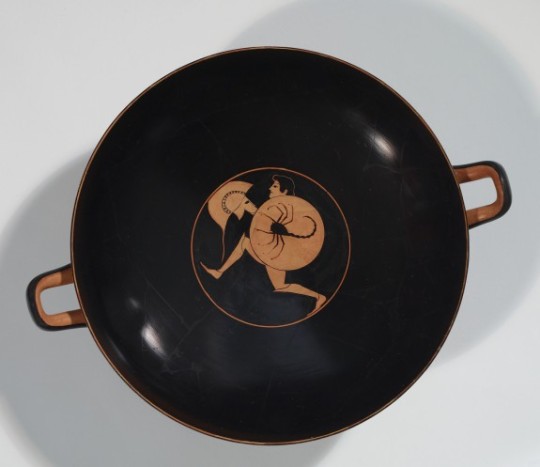
Art of the Day: Kylix with Running Warriors
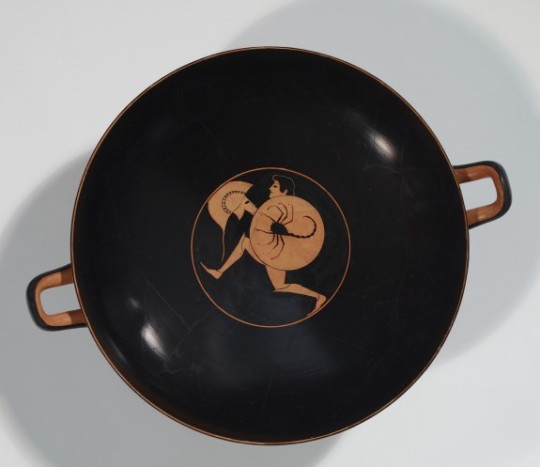
Ten warriors wearing greaves and carrying large, round shields and Corinthian helmets race around the exterior of this kylix (shallow two-handled cup), perhaps participating in a hoplitodromos, a footrace performed while carrying armor as part of the Panathenaic Games. Almost every shield bears a different emblem, including two drinking cups, a bukranion (cow skull), a bird, an anchor, a lion, and two helmets, while a scorpion covers the shield of the single figure decorating the central tondo (medallion). The vessel itself was formed by Pamphaios, who signed his name on the edge of the foot, while an artist known only as the Nikosthenes Painter created the decorative scenes. Kylikes were the most common form of drinking vessel in ancient Greece. The exterior was often elaborately decorated, while the tondo in the center was revealed after the contents of the cup were consumed (the scenes were sometimes amusing as well as artistic). Some kylikes had large eyes painted on the exterior, like this one, making the cup appear to be a mask, with the foot acting as a nose, when the drinker raised the kylix to his mouth. At the end of a symposium, the reveler might have used this kylix to participate in a game of kottabos, which involved flinging the dregs of his wine from his cup at a target. Learn more about this object in our art site: http://bit.ly/2qzLB1f
34 notes
·
View notes